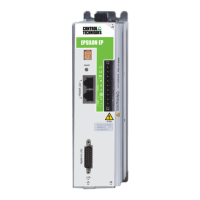130 Epsilon EP-P Drive Reference Manual
www.controltechniques.com Revision: A4
DriveOutput.3=ON ‘Turns ON immediately after Index.2 is started
Wait For Index.AnyCommandComplete
DriveOutput.1=OFF ‘Turns OFF after Index.2’s command is completed
DriveOutput.2=OFF ‘Turns OFF after Index.2’s command is completed
DriveOutput.3=OFF ‘Turns OFF after Index.2’s command is completed
Figure 140: Index Velocity Profile with Drive Outputs
Index.BlendInitiate
This program instruction is used to allow an index to complete its move at the velocity of another index. A blended index accelerates towards
its index velocity using its accel ramp. The index will run at velocity before using its deceleration ramp to accelerate or decelerate towards the
velocity of the next index specified. This differs from the compound index where the index finishes using the accel ramp of the next index.
The index that is to be "blended into" is on the command line in parenthesis immediately after the Index.BlendInitiate command.
Index.BlendInitiate into (1)
This command will cause index zero to finish at the velocity of Index 1. The value within the parenthesis can also be a variable. The following
example will operate the same as the previous.
Index.0.BlendInitiate into (var.var0)
The next index that is to be blended must:
• Exist
• Have the same time base as the present index (synch verus real time)
If the index does not exist or the time base is different, the blended index will convert into a regular compound index.
The direction of the next index (blended into index) is not looked at. Hence, blending an index into another index will not cause the index to
cross through zero velocity.
Example:
Index.0.BlendInitiate into (1)
DriveOutput.1=ON
Index.1.BlendInitiate into (2)
DriveOutput.2=ON
Index.2.Initiate
DriveOutput.3=ON
Wait For Index.AnyCommandComplete
DriveOutput.1=OFF
DriveOutput.2=OFF
DriveOutput.3=OFF
Index.StopTracking
This command is used to cancel the position tracker continuous index once it has been initiated within the program using the Index.#.Initiate
program command. If the Index.#.Initiate input function starts the position tracker index, then Index.#.StopTracking will not stop the tracking
index.
Home.Initiate
This program instruction is used to initiate the home.
A comment is automatically inserted after the Home.Initiate instruction which shows key data about the particular home. The comment starts
with the apostrophe ‘ character.
A “Wait For Home.AnyCommandComplete” instruction is not required because the home is actually a program which already has a “Wait For”
instruction.
Example:
Home.0.Initiate ‘Sensor,Offset=2.000in,Vel=-10.0in/s
Jog.Stop
This program instruction is used to halt jogging using the deceleration ramp setup for the currently operating jog.
Examples:
Wait For DriveInput.2=ON ‘Wait for “Jog –“ input to turn on
Jog.0.MinusInitiate ‘Vel=27.2in/s
Wait For DriveInput.2=OFF ‘Wait for “Jog –“ input to turn off
Jog.Stop ‘Decelerate to a stop
Do While(TRUE) ‘Repeat until the program is halted
If (DriveInput.2=ON) Then ‘Jog+ when DriveInput.2=ON
Jog.0.PlusInitiate ‘Vel=20in/s
Wait For DriveInput.2=OFF ‘Stop when the input goes OFF
Jog.Stop ‘Decelerate to a stop
Endif
If (DriveInput.3=ON) Then ‘Jog- when DriveInput.3=ON

